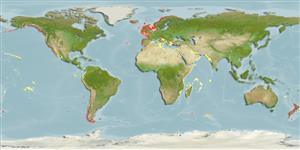Polychaeta |
Sabellida |
Serpulidae
Environment: milieu / climate zone / djupintervall / distribution range
Ekologi
; djupintervall 41 - 90 m (Ref. 905). Subtropical
Indo-Pacific, Northeast Atlantic and the Mediterranean.
Length at first maturity / Size / Weight / Age
Könsmognad: Lm ? range ? - ? cm
A filter feeder (based from the feeding ecology of the family Serpulidae; Ref. 87179). Occurs at depths between 50 to 200 m, in areas of silt to very fine sand (Ref. 96391). Found near hydrothermal vents (Ref. 905). Attached epifauna (Ref. 3123). Also found encrusted under rocks in sheltered shores (Ref. 125338).
Life cycle and mating behavior
Könsmognad | Reproduktion | Lek | Eggs | Fecundity | Larvae
Members of the class Polychaeta are mostly gonochoric (sexual). Mating: Females produce a pheromone attracting and signalling the males to shed sperm which in turn stimulates females to shed eggs, this behavior is known as swarming. Gametes are spawned through the metanephridia or body wall rupturing (termed as "epitoky", wherein a pelagic, reproductive individual, "epitoke", is formed from a benthic, nonreproductive individual, "atoke"). After fertilization, most eggs become planktonic; although some are retained in the worm tubes or burrowed in jelly masses attached to the tubes (egg brooders). Life Cycle: Eggs develop into trocophore larva, which later metamorph into juvenile stage (body lengthened), and later develop into adults.
Salazar-Vallejo, S.I. and M.H. Londoño-Mesa 2004 Lista de especies y bibliografía de poliquetos (Polychaeta) del Pacífico Oriental Tropical. Anales del Instituto de Biología, Universidad Nacional Autónoma de México, Serie Zoología 75(1):9-97. (Ref. 8159)
IUCN Red List Status
(Ref. 130435: Version 2025-1)
CITES status (Ref. 108899)
Not Evaluated
Not Evaluated
Threat to humans
Human uses
| FishSource |
Verktyg
Ytterligare information
Trophic EcologyFood items (preys)FödosammansättningFödointagPredatorer Population dynamicsTillväxt
Max. ages / sizes
Length-weight rel.
Length-length rel.
Length-frequencies
Mass conversion
Abundans
PhysiologySyreförbrukning
Human RelatedStamps, coins, misc.
Internet-källor
Estimates based on models
Preferred temperature
(Ref.
115969): 12.3 - 19.8, mean 14.4 (based on 56 cells).
Price category
Unknown.
